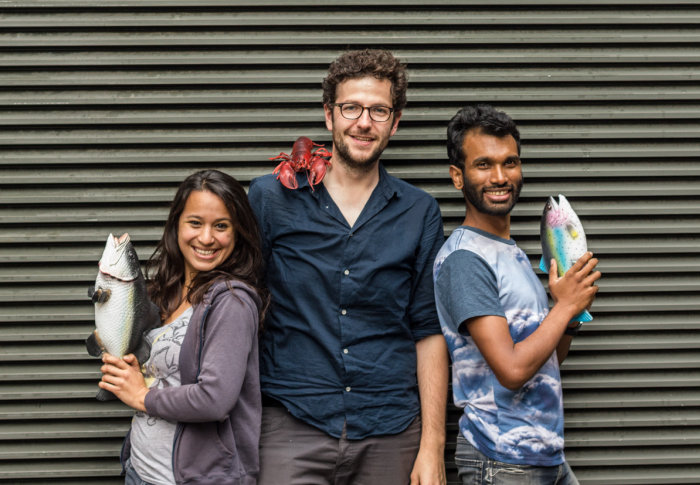Imperial start-up turning the tide on fishing bycatch

The SafetyNet Technologies team
Imperial start-up SafetyNet Technologies has been awarded £1.1million to commercialise their technology which enables more sustainable fishing.
Our aspiration is to create designed products and services that harmonise ocean ecosystems with the coastal communities that depend on them. Aran Dasan Chief Technology Officer
Led by Imperial Alumni Dan Watson and Aran Dasan, alongside Nadia Laabs, the SafetyNet Technologies team have produced a light-emitting device which reduces fishing bycatch – fish and other marine animals that are caught unintentionally other than the target species.
The team are currently set to move into their new premises, which will give them the space required to expand their company.
Reducing bycatch with innovative technology
Each year more than 27 million tonnes of fish are being thrown away, often due to the wrong types of fish being caught, this adversely impacts biodiversity, coastal communities and food security.
SafetyNet are seeking to resolve this using their technology, Pisces, which has been designed alongside scientific researchers and the fishing industry and allows fishers to be more selective of their catch, reducing bycatch by up to 60%. To do this, a series of 10 light-emitting device are fitted to the fishing nets and can be programmed to attract or repel different types of fish.

Much as humans are unable to see UV or infrared light, different marine species can only see certain colours on the light spectrum. This means that certain wavelengths of light can be used to attract or repel one species of fish, while remaining invisible to another.
Working alongside marine biologists, SafetyNet have produced a database of key species and which colours attract or repel them – different wavelengths can signal different things to the fish, such as food, another member of their species or a predator. By utilising this technology, fishers can attract unwanted fish to wider panels of the net that they are able to swim through to escape, or to discourage them from entering the nets in the first place.
Sustainable business model
Aran Dasan, SafetyNet’s Chief Technology Officer, and his co-founder Dan Watson are graduates of the Innovation Design Engineering MSc and MA, run jointly between Imperial's Dyson School of Design Engineering and the Royal College of Art.
Aran is keen to produce technology that will make the fishing industry environmentally sustainable, but also one which is financially viable: “We want it to be a self-sustaining commercial product where it makes financial sense for a skipper to invest in the system.”

The hardware has been successfully field-tested with a variety of species, including a trial in a UK fishery in the North Sea which reduced bycatch by 60 per cent.
Although there are environmental and economic benefits to Pisces, Dasan is aware that this is not necessarily sufficient: “One thing, which I guess links to the Design Engineering School at Imperial, is that we’re not just engineers cranking out technology. One thing we’re really good at is doing ethnography and field research to really understand human behaviour and the motivations for behaviour change and trying to create hardware business models that fit with real human beings.”
Sustainable working environments
The investment is also being used to help the team move into their new warehouse in London Bridge. The space is a blank canvas for the team to create their ideal working environment.
Alongside the practical elements – such as having plenty of bench space, improved tools and machines and space for a production line – Dasan is very keen to create a community with other sustainable businesses: “We got started in coworking spaces and we really like those other companies around us to bounce ideas off.”

Already joining them is an electric motorbike company that they’ve co-worked with previously and Dasan is particularly excited at the prospect of creating a working space with other Imperial teams: “Another Imperial start-up is looking at moving in, which works on robotics in the sustainable energy sector. We’re hoping they’ll be keen.”
The team are looking forward to being able to create their ideal working environment: “We’ve started to do a bit of communal cooking as well, so it’s got a big kitchen area for lunches. I’ve described a utopia, we’ll see if it actually ends up that way!”
Looking forward
Dasan has begun to think about potential developments for the technology. He explained that he would like to create an underwater technology platform that connects fishing vessels to serve other long term societal and environmental purposes in the ocean.
"Our aspiration is to create designed products and services that harmonise ocean ecosystems with the coastal communities that depend on them."
Article text (excluding photos or graphics) © Imperial College London.
Photos and graphics subject to third party copyright used with permission or © Imperial College London.
Reporter
Sarah Reid-Collins
Communications and Public Affairs